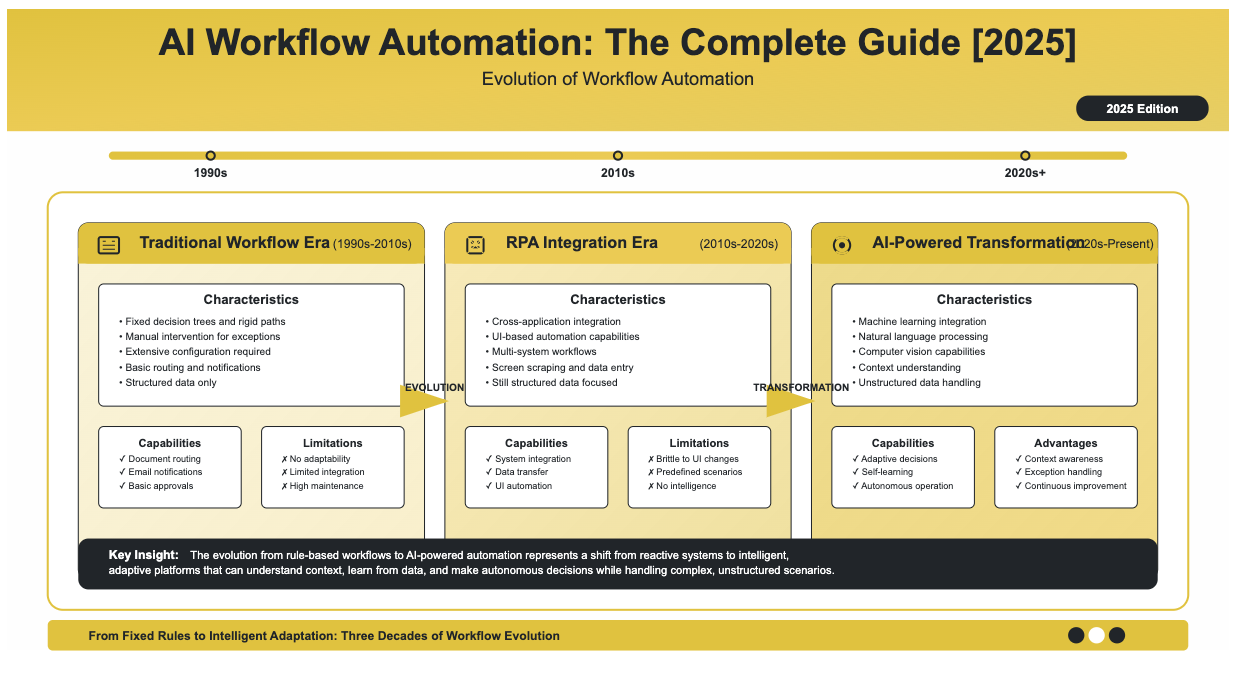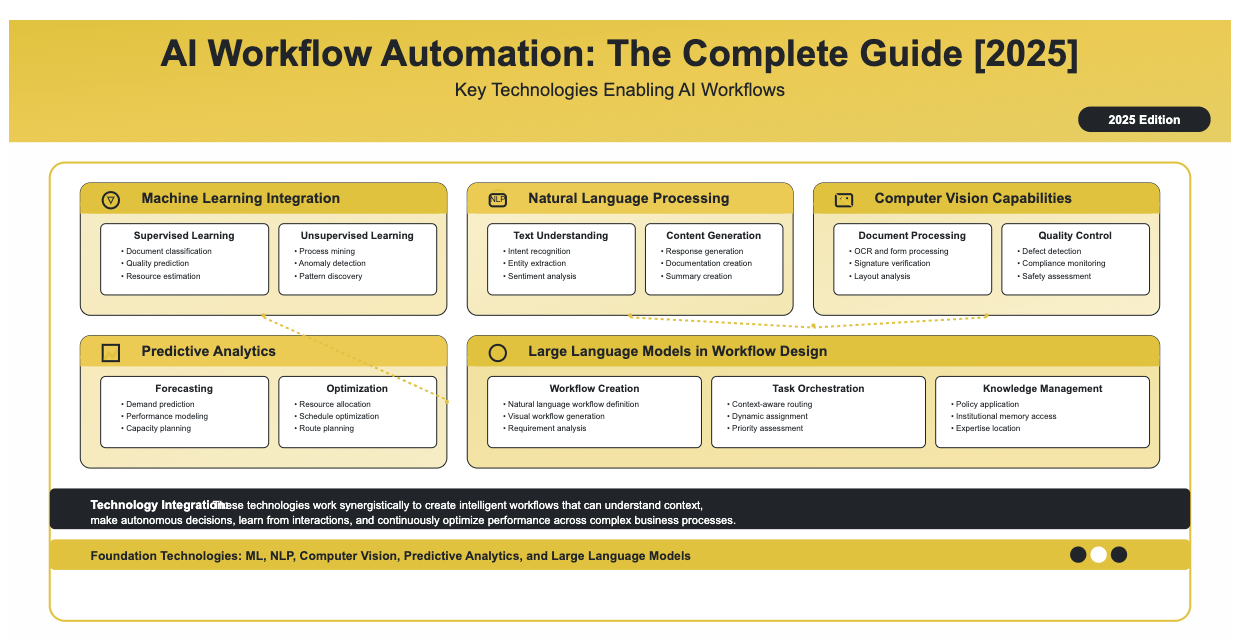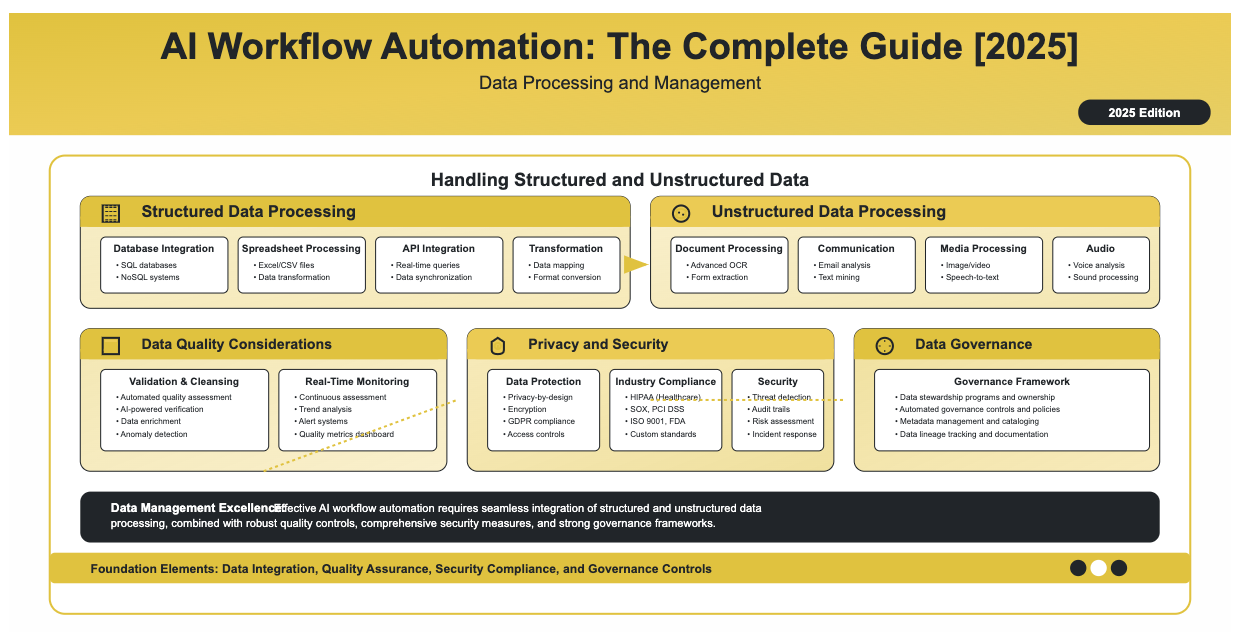Introduction
AI workflow automation represents the next evolution in organizational efficiency, combining systematic workflow management with the intelligent decision-making capabilities of modern AI systems. This technology transforms how businesses operate by enabling workflows that can understand context, make complex decisions, and adapt to new situations without explicit programming.
Business Impact: Organizations implementing AI workflow automation report 60-85% reduction in processing times, 70-95% decrease in errors, and 40-65% lower operational costs while handling 200-500% volume increases without proportional staff increases, according to Deloitte’s State of AI in the Enterprise report.
This guide is part of our comprehensive AI automation series – explore our complete resource library at the bottom of this page.
Evolution of Workflow Automation
Traditional Workflow Era (1990s-2010s)
Early workflow systems operated with fixed decision trees, requiring manual intervention for exceptions and extensive configuration for each scenario. They excelled at basic routing and notifications but were limited to predetermined paths and structured data.
RPA Integration (2010s-2020s)
Robotic Process Automation brought cross-application integration and UI-based automation, enabling workflows to interact with multiple systems. However, these still relied on structured data and predefined scenarios.
AI-Powered Transformation (2020s-Present)
Modern AI workflow automation leverages machine learning, natural language processing, and computer vision to create intelligent systems that understand context, make adaptive decisions, and handle unstructured data autonomously.

How AI Transforms Traditional Workflows
Intelligent Decision Making
AI workflows replace rigid rule-based logic with contextual understanding, enabling:
- Content Context Analysis: Understanding the meaning and intent behind documents and communications
- Dynamic Route Selection: Choosing optimal paths based on current conditions and patterns
- Predictive Processing: Anticipating needs and preparing resources proactively
- Adaptive Prioritization: Adjusting task priorities based on business impact and urgency
Unstructured Data Processing
Unlike traditional workflows limited to structured forms, AI automation excels at:
- Document Intelligence: Extracting information from contracts, invoices, and reports regardless of format
- Natural Language Understanding: Processing emails, chat messages, and support tickets for intent and sentiment
- Image and Video Analysis: Incorporating visual information into decision-making processes
- Audio Processing: Converting speech to text and analyzing tone and urgency
Self-Optimization Capabilities
AI workflows continuously improve through:
- Pattern Recognition: Automatically identifying efficiency opportunities and bottlenecks
- Performance Analytics: Measuring and optimizing processing times and resource utilization
- Predictive Maintenance: Anticipating system issues and scheduling preventive actions
- Automatic Tuning: Adjusting parameters based on performance feedback
Fundamentals of AI Workflow Automation
Core Components
Workflow Engine: Foundational orchestration layer managing task sequencing, data flow, and process execution with event management and resource allocation.
AI Integration Layer: Intelligent components enabling advanced decision-making through model orchestration, API integration, training data management, and model versioning.
Data Processing Framework: Comprehensive data handling for ingestion, transformation, storage, and real-time analytics across diverse information types.
Integration Infrastructure: Connecting workflows with existing systems through API management, security frameworks, monitoring systems, and deployment tools.
Traditional vs. AI-Enhanced Workflows
Traditional Workflows:
- Rule-based processing with predetermined decision trees
- Limited to structured data in predefined formats
- Stop execution when encountering unexpected scenarios
- Require manual updates for business rule changes
AI-Enhanced Workflows:
- Contextual decisions using machine learning models
- Process structured, semi-structured, and unstructured data
- Attempt an intelligent resolution of exceptions and learn from patterns
- Automatically adapt to changing patterns and requirements
Key Technologies Enabling AI Workflows
Machine Learning Integration
- Supervised Learning: Document classification, quality prediction, resource estimation, risk assessment
- Unsupervised Learning: Process mining, anomaly detection, clustering analysis, pattern discovery
Natural Language Processing (NLP)
- Text Understanding: Using frameworks like spaCy and Transformers, with capabilities including intent recognition, entity extraction, sentiment analysis, and language translation.
- Content Generation: Response generation, documentation creation, summary creation, template customization
Computer Vision Capabilities
- Document Processing: Using OpenCV and Tesseract OCR, enabling OCR, form processing, signature verification, and layout analysis.
- Quality Control: Defect detection, compliance monitoring, safety assessment, progress tracking
Predictive Analytics
- Forecasting: Demand prediction, performance modeling, capacity planning, risk forecasting
- Optimization: Resource allocation, schedule optimization, route planning, parameter tuning
Large Language Models in Workflow Design
- Workflow Creation: Natural language workflow definition, visual workflow generation, requirement analysis
- Task Orchestration: Context-aware routing, dynamic assignment, priority assessment, escalation management
- Knowledge Management: Policy application, institutional memory access, expertise location, continuous learning

Designing Effective AI Workflows
Process Mapping and Analysis
Current State Assessment:
- Process Discovery: Stakeholder interviews, process mining, documentation review
- Value Stream Mapping: End-to-end visualization, input analysis, process flow documentation, output evaluation
- Gap Analysis: Performance gaps, technology gaps, automation opportunities
Identifying Automation Opportunities:
- High-Value Candidates: Volume/frequency criteria, complexity evaluation, business impact analysis
- AI Enhancement Opportunities: Addressing traditional automation limitations, adding predictive capabilities, creating adaptive behavior
Human-in-the-Loop vs. Fully Automated Design
Human-in-the-Loop (HITL):
- Strategic Involvement: Creative problem solving, relationship management, strategic decisions, quality assurance
- Collaboration Patterns: AI-assisted decisions, human-guided AI, escalation management, validation loops
- Implementation: Risk-based routing, threshold management, feedback integration
Fully Automated Design:
- Readiness Criteria: Well-defined rules, predictable inputs, measurable outcomes, low risk impact
- Safety Mechanisms: Monitoring systems, circuit breakers, rollback capabilities, human override
- Progressive Strategy: Pilot implementation, staged rollout, performance validation, risk mitigation
Decision Points and Branching Logic
AI-Powered Decision Architecture:
- Context-Aware Decisions: Multi-factor analysis, dynamic rule evaluation
- Intelligent Branching: Probabilistic routing, content-based routing
- Advanced Logic: Classification systems, prediction-based routing, continuous learning
Error Handling and Exception Management:
- Proactive Prevention: Data validation, predictive error detection
- Intelligent Resolution: Self-healing capabilities, escalation management
- Learning from Exceptions: Root cause analysis, process improvement
AI Workflow Automation Tools
Major Platform Overview
Enterprise-Grade Platforms:
- Microsoft Power Automate: Cloud-based with 400+ connectors, AI Builder integration, strong Office 365 integration
- UiPath: Advanced RPA with AI Fabric, sophisticated document processing, process mining capabilities
- Zapier: Simple integration platform connecting 5,000+ apps with basic AI features
- Make: Visual workflow builder with advanced logic and real-time processing
- n8n: Open-source foundation with extensible architecture and advanced AI workflow capabilities
Platform Comparison
Scalability: Enterprise platforms handle thousands of concurrent workflows; mid-market solutions suit hundreds to low thousands; open-source platforms offer custom scaling based on infrastructure investment.
AI Capabilities: Varies from comprehensive AI suites (Power Automate, UiPath) to basic AI integration (Zapier) to maximum customization flexibility (n8n).
Integration: Enterprise platforms offer extensive pre-built connectors; open-source solutions provide unlimited customization potential.
n8n for Advanced AI Workflows
Platform Advantages
- Open-Source Foundation: Complete transparency and control with self-hosted or cloud options
- Node-Based Design: Modular architecture with event-driven processing
- Extensibility: Custom node development and community contributions
- AI Integration: Native AI nodes, custom AI integration, vector database support, model chaining
Setting Up AI Workflows
- Installation: Docker-based setup with environment configuration for production use
- Basic Workflow Creation: Email processing example with content analysis, decision logic, and automated actions
- AI Integration: Native AI nodes, custom AI integration, vector database support
Advanced Capabilities
- Workflow Patterns: Document approval workflows, customer service automation, data processing pipelines
- Performance Optimization: Parallel processing, memory management, AI model optimization, monitoring systems
Data Processing and Management
Handling Structured and Unstructured Data
Structured Data: Database integration (SQL and NoSQL), spreadsheet processing, API integration with real-time queries, and data transformation.
Unstructured Data: Document processing with advanced OCR, email and communication analysis, image/video processing, and audio processing with speech-to-text.
Data Quality Considerations
- Validation and Cleansing: Automated quality assessment, AI-powered data verification, data enrichment
- Real-Time Monitoring: Continuous quality assessment, trend analysis, alert systems, quality metrics dashboard
Privacy and Security
- Data Protection: Privacy-by-design implementation, encryption and security, GDPR compliance
- Industry Compliance: Healthcare (HIPAA), financial services (SOX, PCI DSS), manufacturing (ISO 9001, FDA)
- Data Governance: Stewardship programs, automated governance controls, metadata management

Measuring Success and ROI
Key Performance Indicators
Operational Efficiency Metrics:
- Processing speed: End-to-end duration, throughput measurements
- Quality indicators: Error rate tracking, first-time success rate
- Resource utilization: Human resource impact, technical resource efficiency
Business Impact Measurements:
- Customer experience: Response time, service quality, satisfaction scores
- Financial performance: Cost reduction, revenue enhancement
ROI Calculation
Investment Components: Technology costs (platform licensing, AI services, infrastructure), implementation investment (professional services, internal resources, training), and ongoing operational costs.
Benefit Quantification: Direct savings (labor cost reduction, error correction savings) and indirect value creation (revenue enhancement, risk mitigation).
ROI Formula: (Total Benefits – Total Costs) / Total Costs × 100
Continuous Improvement
- Data-driven optimization: Performance analytics, A/B testing, predictive improvement
- Stakeholder feedback: User experience optimization, customer impact assessment
- Innovation integration: Technology evolution, business process evolution
Common Challenges and Solutions
Technical Integration Issues
- Legacy System Integration: API limitations, data format incompatibility, security constraints
- Solutions: Middleware development, screen scraping with RPA, data synchronization strategies
Performance and Scalability
- System Optimization: Parallel processing, caching strategies, load balancing, AI model optimization
- Scalability Planning: Horizontal scaling, auto-scaling, cloud migration strategies
Data Quality Problems
- Quality Issues: Incomplete records, format inconsistencies, duplicate entries, outdated information
- AI Solutions: Automated data cleansing, continuous quality monitoring, data governance implementation
User Adoption Hurdles
- Change Management: Employee resistance, skill development concerns, technology complexity
- Solutions: Communication and transparency, comprehensive training, gradual implementation, user experience optimization
Future of AI Workflow Automation
Emerging Trends
- Multimodal AI Systems: Vision-language models, audio-visual processing, sensor data integration
- Autonomous Agent Networks: Collaborative AI systems, agent specialization, self-organizing workflows
- Quantum Computing Integration: Enhanced optimization, pattern recognition, and cryptographic security as explored by IBM Quantum Network and Google Quantum
Predictive and Prescriptive Workflows
- Advanced Forecasting: Multi-horizon prediction (short-term to long-term strategic planning)
- Prescriptive Analytics: Actionable recommendations, decision optimization, automated decision execution
Self-Optimizing Workflows
- Performance Self-Monitoring: Real-time analysis, adaptive learning, automatic process refinement
- Cross-Organization Integration: Supply chain integration, industry ecosystem workflows, collaborative intelligence
Implementation Roadmap
Phase 1: Strategic Planning (Months 1-2)
- Assessment: Current state analysis, technology readiness, stakeholder alignment
- Goal Setting: Process prioritization, success metrics definition
Phase 2: Design and Planning (Months 3-4)
- Detailed Design: Process mapping, technology selection, integration architecture
- Prototype Development: MVP development, testing, and validation
Phase 3: Pilot Implementation (Months 5-7)
- Proof of Concept: Limited scope implementation, performance measurement
- Validation: ROI confirmation, lessons learned documentation
Phase 4: Scaling (Months 8-12)
- Enterprise Rollout: Gradual expansion, resource scaling, training programs
- Optimization: Performance monitoring, process refinement, capability enhancement
Phase 5: Maturity (Months 12+)
- Advanced Capabilities: AI model enhancement, process innovation, cross-functional integration
- Continuous Improvement: Ongoing optimization and evolution
Key Success Factors
Strategic Implementation Principles
- Start Small, Scale Smart: Begin with high-impact, low-complexity processes
- Focus on Business Value: Prioritize automation opportunities with clear ROI
- Invest in Change Management: Success depends on user adoption and organizational buy-in
- Plan for Continuous Evolution: AI workflow automation is an ongoing journey
Critical Success Factors
- Executive Sponsorship: Strong leadership support is essential
- Cross-Functional Collaboration: Involve all stakeholders in planning and implementation
- Quality Data Foundation: Ensure data quality and accessibility before automation
- Comprehensive Training: Invest in user education following ADKAR change management model and skill development
Common Pitfalls to Avoid
- Automating Broken Processes: Fix processes before automating them
- Underestimating Change Management: Plan extensively for organizational change
- Neglecting Security and Compliance: Build security and compliance into automation from the start
- Over-Promising Results: Set realistic expectations and communicate honestly about capabilities
Conclusion
AI workflow automation represents a transformative approach to business process management that goes beyond traditional automation. By combining machine learning, natural language processing, computer vision, and intelligent workflow orchestration, organizations can create systems that not only automate routine tasks but also handle complex decisions, learn from experience, and continuously improve performance.
The business impact is substantial: significant efficiency gains, cost reductions, quality improvements, and enhanced customer experiences. However, success requires careful planning, appropriate technology selection, robust implementation strategies, and thoughtful integration of human oversight.
As AI technologies continue to evolve, organizations that master these fundamentals will be well-positioned to adapt to new capabilities and maintain a competitive advantage in an increasingly automated business environment. The key is to start with clear objectives, implement systematically, and build organizational capabilities that support continuous learning and improvement.
Whether implementing simple automation workflows or complex AI-driven processes, the framework provided in this guide enables organizations to make informed decisions and achieve successful outcomes in their digital transformation journey. The future belongs to organizations that can effectively combine human creativity and judgment with AI capabilities for processing, analysis, and optimization.
Comprehensive AI Automation Resources for Every Business Need
This specialized guide focuses on designing, implementing, and optimizing intelligent workflows that transform your operational processes.
As part of our comprehensive AI automation series, this resource provides detailed methodologies for workflow automation success across your organization. From here, you can access our complete library of specialized resources that cover every aspect of AI automation strategy, implementation, and optimization.
Our structured guide series takes you from foundational concepts through advanced implementation strategies, ensuring you have the knowledge and frameworks needed for successful AI automation deployment at any scale.
Each specialized guide builds upon core concepts while diving deep into specific areas of AI automation, providing both strategic insights and practical implementation guidance tailored to your organizational needs and objectives.
Resources and Further Learning
Explore Our AI Automation Content Categories
Continue your exploration with our in-depth coverage of specific topics:
- AI Automation Fundamentals – Core concepts and foundational knowledge
- AI Workflow Automation – Process design and implementation strategies
- AI Agents & Assistants – Intelligent agent development and deployment
- Custom AI Solutions – Build vs. buy decisions and custom development
- Business Impact & ROI – Value measurement and business case development
Stay Updated on AI Automation Developments
The field of AI automation evolves rapidly. To stay current with the latest developments:
- Follow our blog for regular analysis of emerging trends and technologies
- Access our resource library for templates, frameworks, and implementation tools
- Join professional communities to connect with other practitioners
- Subscribe to industry publications for ongoing insights and updates
FREQUENTLY ASKED QUESTIONS
Traditional workflow automation relies on rigid rule-based logic and predetermined decision trees, requiring manual intervention for exceptions and working only with structured data in predefined formats.
AI workflow automation transforms this by using contextual understanding and machine learning to make intelligent decisions, process unstructured data (emails, documents, images), and automatically resolve exceptions.
For example, while traditional workflows stop when encountering unexpected invoice formats, AI workflows use computer vision and natural language processing to understand various formats and learn from each processed document, continuously improving performance.
The best candidates are high-volume processes (handling large transaction volumes), decision-intensive workflows (requiring complex analysis and routing), unstructured data processing (emails, documents, images), and exception-heavy processes (frequent variations requiring human intervention).
Ideal applications include customer service automation (60-85% reduction in processing times), document approval workflows, invoice processing, customer onboarding, and quality control processes.
Look for processes where you need contextual understanding, adaptive decision-making, or handling of multiple data types simultaneously.
This depends on your process complexity and risk tolerance.
Human-in-the-Loop is best for strategic decisions, creative problem-solving, relationship management, and high-risk processes where human oversight adds value. Use HITL for processes requiring empathy, complex judgment, or regulatory oversight.
Fully automated workflows work well for processes with well-defined rules, predictable inputs, measurable outcomes, and low-risk impact. Start with HITL approaches for complex processes, then gradually move toward full automation as confidence and performance improve.
Many successful implementations use hybrid approaches where AI handles routine decisions while escalating complex cases to humans.
Platform choice depends on your technical expertise, scalability needs, and integration requirements.
Enterprise platforms like Microsoft Power Automate (400+ connectors, strong Office 365 integration) and UiPath (advanced RPA with AI capabilities) are ideal for large organizations needing extensive pre-built integrations.
Mid-market solutions like Zapier (5,000+ app connections, simple setup) work well for smaller teams.
Open-source platforms like n8n (our preferred choice) offer maximum customization and control, perfect for organizations with technical expertise wanting unlimited flexibility.
Consider factors like your team’s technical skills, existing system integrations, scalability requirements, and budget constraints when choosing.
Organizations typically see substantial returns: 60-85% reduction in processing times, 70-95% decrease in errors, 40-65% lower operational costs, and the ability to handle 200-500% volume increases without proportional staff increases.
Measure success through operational efficiency metrics (processing speed, error rates, resource utilization), business impact measurements (customer satisfaction, cost reduction, revenue enhancement), and ROI calculation: (Total Benefits – Total Costs) / Total Costs × 100.
Most organizations see positive ROI within 6-12 months.
Key success factors include starting with high-impact processes, investing in change management, ensuring data quality, and planning for continuous improvement rather than one-time implementation.
These fundamentals provide the foundation for successful AI workflow automation implementation. For specific platform guidance, advanced integration strategies, and industry-specific applications, explore our comprehensive AI automation resources.
About This Guide
This comprehensive guide is maintained by industry experts and researchers who work directly with organizations implementing AI automation solutions. Content is regularly updated to reflect the latest developments in technology, best practices, and industry applications.
Last Updated: June 2025
This guide represents analysis of current AI workflow automation technology and best practices. Individual results may vary based on organizational context, implementation approach, and specific use cases.
Was this guide helpful?
